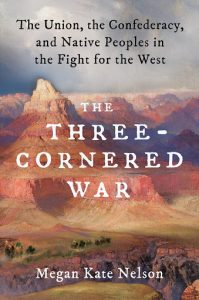Book Review: The Three-Cornered War
 1st Colorado, 1st New Mexico, Battle of Peralta, Juanita— names not usually and immediately associated with the American Civil War lexicon. Yet far from the gory battlefields of Shiloh and Gettysburg, the conflict that erupted in 1861 also embroiled the Southwest United States and determined whether the Confederacy could stretch its reach to the gold fields of California and the waters of the Pacific Ocean. The war between the North and South also embroiled Native Americans, who were themselves trying to chart a course through the uncertainty of the expanding United States.
1st Colorado, 1st New Mexico, Battle of Peralta, Juanita— names not usually and immediately associated with the American Civil War lexicon. Yet far from the gory battlefields of Shiloh and Gettysburg, the conflict that erupted in 1861 also embroiled the Southwest United States and determined whether the Confederacy could stretch its reach to the gold fields of California and the waters of the Pacific Ocean. The war between the North and South also embroiled Native Americans, who were themselves trying to chart a course through the uncertainty of the expanding United States.
With Megan Kate Nelson’s new history, these various components are brought to the forefront, told through the prism of a collection of nine historical figures that “illuminate the ways that New Mexico become a pivotal theater of the Civil War, the center of a larger struggle for the future of the nation, of Native peoples, and of the West” (pg. xx).
In a sweeping narrative, using her nine characters as touchstones, Nelson crafts a history that takes the reader through the New Mexico Campaign of 1862, which in itself had two firsts: the first integrated army in the Civil War when Hispanos of the 1st New Mexico, under the command of Kit Carson joined the forces that fought at Valverde, and the only United States territory capital captured by the Confederacy, Santa Fe.
Nelson’s book captures the role of Native American tribes, especially the Navajos and their plight in the territory, during the war and Reconstruction years.
One of the more poignant accounts is the story of Juanita, the wife of the Navajos leader Manuelito. Through that account, Nelson traces the dire situations of their band of Navajos and the gut-wrenching decisions that the Union army, white encroachment, and the internecine raiding between various Native American tribes had on the impact of the entire population. In the end, Juanita and the Navajos return to their beloved homeland, Dine Bikeyah, victory in defeat. For the return of “freedom from the U.S. government, the Navajos had to accede to new methods of federal control” (pg. 246). The Civil War had changed forever the dynamic of the southwest.
The book comes to a hard realization, captured in the final paragraphs of the history:
“The struggles for power in the West exposed a hard and complicated truth about the Union government’s war aims: that they simultaneously embraced slave emancipation and Native extermination in order to secure an American empire of liberty” (pg. 252).
The themes Nelson puts forth, the historical characters she introduces, and the depth of research she handles all make this book a great starting point for further exploration into the American Civil War in the Southwest United States. Regardless of which of the three routes–Union, Native American, or Confederate—your interests lies, this book highlights what those converging paths meant: a tri-cornered war and the continued shaping of the west.
————
The Three-Cornered War by Megan Kate Nelson
352 pages, published by Scribner, February 11, 2020

While I am aware of the role of Eli Parker, this read made me want to learn what the role of the whole Iroquois Nation was during the Civil War.
PLEASE ALSO SEE THE WRITE UP IN THIS MONTH MONITOR MAGAZINE .
IF INTERESTED .
BILL THERE IS A FINE BOOK WRITTEN ON THE Iroquois ALVB FROM THE BUFFALO HISTORICAL SOCIETY OR ECHOS THROUGH TIME Learning CENTER . APPEARS TO BE A VERY GOOD READ .
Thanks for the review. Will definitely want to check it out.
I just bought this. I’ve read other books on the Civil War in the Southwest, and been to Glorieta Pass and done the ranger guided drive along tour (just me and a local ranger right before a snow storm). Looking forward to reading what Megan Kate Nelson has found to say on this time and place.
hi,
the author’s summation that “The struggles for power in the West exposed a hard and complicated truth about the Union government’s war aims: that they simultaneously embraced slave emancipation and Native extermination in order to secure an American empire of liberty” warrants a rebuttal.
1. the defeat of the texans occurred in the winter of ’62. emancipation was not a war aim at that time.
2. native extermination was never a war aim in lincoln’s administration or in later ones. defeat, submission, relegation to reservations, converting the plains indians to an economy based on agriculture, etc, and a conversion to christianity were the often conflicting political aims of the national government at this time. although extermination was the goal of some of the colonial settlers who moved into texas, the southwest, colorado, etc. and was executed by local commanders, it wasn’t a national policy.
3. empire of liberty — the author should have expounded upon what this vacuous statement could have meant. an empire is the epitome of the denial of liberty.